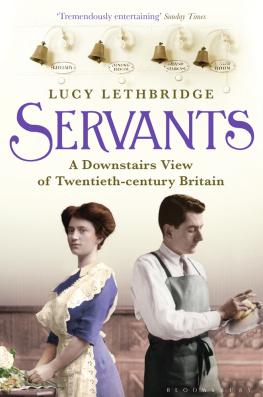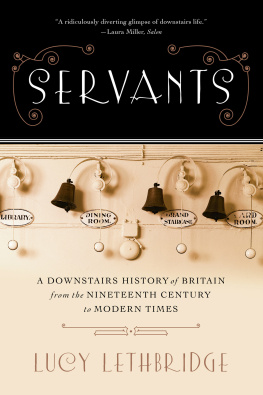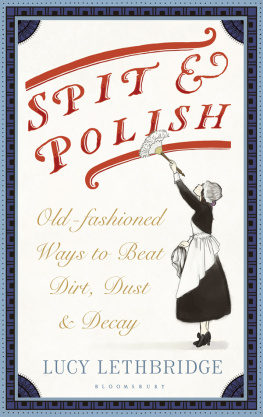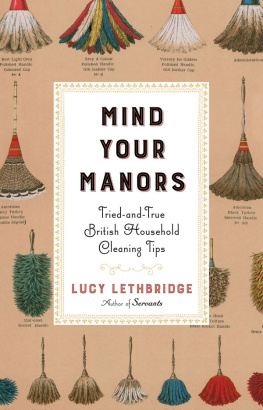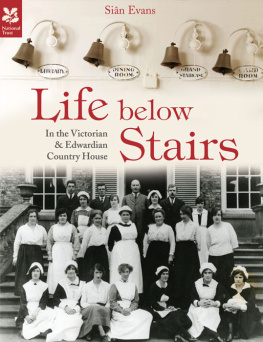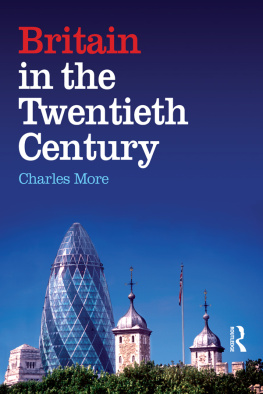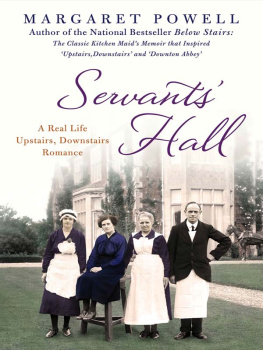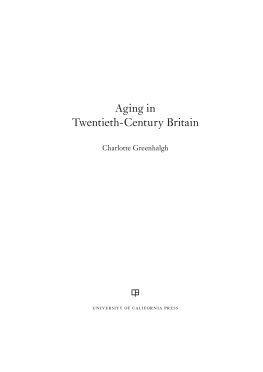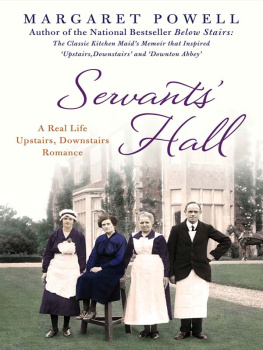LUCY LETHBRIDGE has written for a number of publications and is also the author of several childrens books, one of which, Who Was Ada Lovelace? , won the 2002 Blue Peter Award for non-fiction. She lives in London.
I am indebted to all those who took the time to share their memories of work and life in service or who introduced me to the recollections of friends and relations. Not everyone appears in the book by name but all have been invaluable in adding pieces to the background jigsaw. My thanks therefore to those I interviewed in person: Ann Stallard, Joy Schreiber, Marion Smith, Enid Fields, Gretta Guy, Peter Telford, Pearl Scott and Horace Mortiboy; Jenny and Pat Duncan I came to know through Pamela Hatfield; Colin Lee was introduced to me by Rosalind Morrison and Fred Collett by Dorothy Bell RSCJ. Hazel Munting invited me to read the journals of her great uncle Ernest Squire and Jackie Best to listen to the recorded memories of her mother Margaret Flockhart; Luz Bansil and her sister told me about their experiences of thirty years of housekeeping in London. The insights provided by many correspondents were also invaluable. My thanks to Jean Arnold, Hope Gilbert, Doreen Warwick, Ann Humpage, K. M. Hayles, Barbara Worman, June Morris, Peter Rankilor, Joan Crook, Eileen Sayer, Mary Woodhouse, Dennis Parratt, Dorothy Schulz, Jackie Day, Chris Noonan, Wallace Giddings, Elva Lipscomb, Joyce Helps, J. E. Bratton, Robert E. Reece, Bairnie Henderson, Margit Latter, Audrey King, Roger Kingsley (who had written his memories of Marieken), June Morris, Winifred Hadland and Anne Baird.
Piers and Vyvyen Brendon, Giles Waterfield and Alison Light let me pick their brains in the early stages of the project, as did Dr Anthony Grenville of the Association of Jewish Refugees. It was my friend Crispin Jackson who discovered the diaries of Alice Osbourn; Andrew Barrow sent me the tape recording of his interview with a servant in the royal household; Miriam James told me of the letters of Gwendoline Rush in the Bodleian; and Penelope Billyeald let me read her unpublished thesis, What the Butler Did Not Do: The Function of the Domestic Servant in the Crime and Detective Fiction of the Golden Age ; Phil Baker put me on to Curious Relations . Many thanks also to Stephanie Rough and Laura Hurrell of Greycoat Placements, Rebekah Frankcom of the Norland Institute and Angela Montfort-Bebb of Universal Aunts.
Many friends have in different ways been instrumental in the making of the book. Jeremy Lewis is, as always, a fount of invigorating enthusiasm and to the generosity of both Jeremy and Petra I owe much. Selina OGrady, Tony Curzon-Price, Jane OGrady, Kathy OShaughnessy and Daniel Jeffreys were unstinting in their encouragement. As was Claudia Fitzherbert: my thanks to her and to Fram Dinshaw for their months of hospitality. Simon and Jenny Haviland are the most generous of friends and neighbours and, Kiloran Howard and Sarah Cole uncomplainingly put me up at short notice and at all hours. Thanks also to Jane Mulvagh, Tessa Boase and Nick Glass.
My wonderful editor Michael Fishwick must at times have wondered if I would ever finish, so many thanks to him, to Simon Trewin, and to the brilliant Bloomsbury team who brought everything to fruition with such patience and polish: Anna Simpson, Paul Nash, Phillip Beresford, Oliver Holden-Rea, Kate Johnson, Catherine Best and David Atkinson.
Finally, my family have been unfailingly supportive over the vicissitudes of the last five years and I owe them more than I could possibly put into words. My sister Anna is my beadiest critic and I am very grateful for all her support and encouragement. The love of my parents is the foundation of the writing of this book and it is for them.
True Stories of Pirates
Napoleon
Florence Nightingale
Who Was Ada Lovelace?
Who Was St Francis of Assisi?
Who Was Annie Oakley?
A Deep But Dazzling Darkness (co-editor)
Chapter 1
In 1901, in a slim volume published to mark the accession of Edward VII, the author, identified only as One of His Majestys Servants, sketched an idyllic picture of domestic life in the royal household, stressing the new monarchs domestic rectitude, and his homely side, hitherto unknown to his subjects: Few people outside the Royal Family and the circle that is honoured by the Kings intimate friendship are aware of the high standard of domestic life that he has always set himself and observed. Not only, wrote the author, did the marriage of King Edward VII and Queen Alexandra have the savour of the once-upon-a-time fairy period or the poetic middle ages, but the royal couple loved nothing more than to meet for tea, that cosiest of occasions heralding a gargantuan command performance with a seemingly inexhaustible supply of cakes both hot and cold, sandwiches of all kinds, rolls and jams.
To celebrate the sanctity of the English teatime, in 1902, Queen Alexandra invited 10,000 of Londons maids-of-all-work to tea parties across the capital to mark the Coronation. The teas were orchestrated by the Office of the Bishop of London and The Times reported that between 10 July and 2 August, although it poured with rain almost incessantly, the girls gathered for tea, white and brown bread and butter, jam, lettuces and watercress, seed cake, iced plum cake and strawberries. These were the tweenies, the skivvies, the slaveys, the grafters: girls who slept in basement kitchens next to the stove, or in tiny bedrooms under the eaves, where it was either freezing cold or oppressively hot. From Norwood, Tottenham, St Pancras, St Albans and Camberwell they came, and were entertained with music, fancy sketches and similar treats by the ladies of the local branches of the Metropolitan Association for Befriending Young Servants (MABYS) and other benevolent institutions. The Bishop of London, Arthur Winnington-Ingram, stood on a table in the Zoological Gardens in Regents Park to address the throng and reminded them of their vital role in the development and expansion of the Empire. One thousand teas were served in the gardens of the Bishops Palace in Fulham. We carried it off as well as we could, remembered the Bishop, except that a thousand girls insisted on kissing the band, but as the band did not seem to mind there was no harm done.
No aspect of the home spoke quite so eloquently to the English middle-class idea of the ordered life than the presence of servants. From the bustling subterranean townships employed on the landed estates, to the maid-of-all-work who did for the rapidly expanding middles, as representatives of the nations sense of natural and social order, the deferential servant was as necessary to the English pyramid of social life as the squire or the parson. Foreign visitors to England often marvelled at the efficiently orchestrated hospitality for which the English had become famous. In 1832, on a year-long tour round England, the Prussian Prince Puckler-Muskau reported that: The treatment of servants is as excellent as their performance of their duties. Each has his prescribed field of activities; in which, however, the strictest and most punctual execution of orders is expected of him... At the same time the servants enjoy a reasonable freedom, and have certain portions of time allotted to them, which their master carefully respects. The whole treatment of the servant classes is much more decorous, and combined with more gards than with us; but then they are so entirely excluded from all familiarity, and such profound respect is exacted from them, that they appear to be considered rather as machines than as beings of the same order.
The labour which facilitated such an impression of effortlessness was, on the whole, silent, subservient and multitudinous. There was perceived to be an upward momentum for the good servant, a seat at the head of the servants table. Servants, in my childhood, wrote Susan Tweedsmuir of her youth in a country house at the turn of the century, came young to a large house, worked very hard, were promoted, worked less hard as the years went by; were caught up into an empyrean where they had a sitting room of their own. They then wore a black silk dress and were waited on by the under-servants.
Next page
